Order Passeriformes Genus Furnarius Higher classification Hornero | Phylum Chordata Family Furnariidae Scientific name Furnarius rufus Rank Species | |
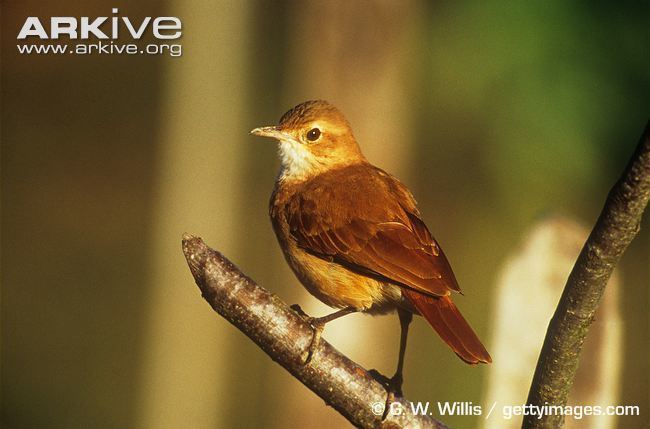 | ||
Similar Hornero, Bird, Ovenbird, Passerine, Chalk‑browed mockingbird | ||
Bird engineering rufous hornero bird building its nest furnarius rufus
The rufous hornero (Furnarius rufus) is a medium-sized ovenbird in the family Furnariidae It occurs in eastern South America, and is the national bird in Argentina. Also known as the red ovenbird, it is common in savannas, second-growth scrub, pastures and agricultural land and is synanthropic. Its range includes southeastern and southern Brazil, Bolivia, Paraguay, Uruguay and northern and central Argentina, extending as far south as northern Patagonia. The species is most closely related to the crested hornero of Paraguay and Argentina. There are four accepted subspecies.
Contents
- Bird engineering rufous hornero bird building its nest furnarius rufus
- Predators
- Breeding
- Status
- Taxonomy and systematics
- Subspecies
- Description
- References
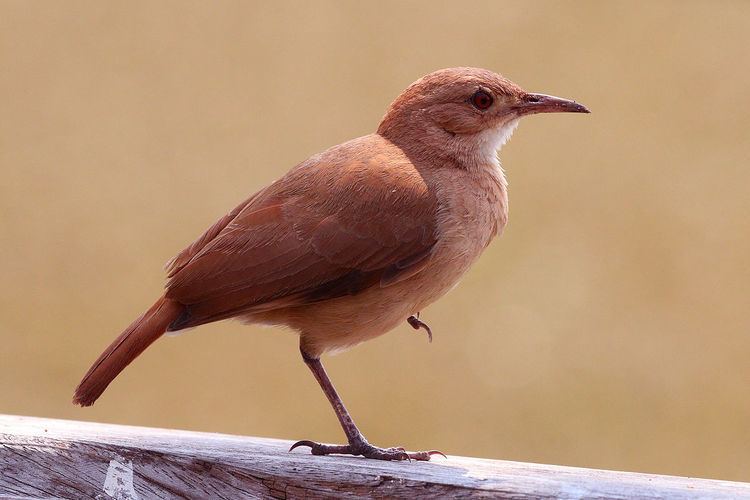
The rufous hornero is medium-sized with a square tail and very slightly decurved bill. The plumage is overall reddish brown with a dull brown crown and a whitish throat. Sexes are alike and juvenile birds are slightly paler below (probably because they are cleaner). Rufous horneros feed on insects and other arthropods obtained by foraging on the ground while walking. They sometimes feed on scraps such as bread crumbs. Songs in the rufous hornero are sexually distinct. The rapid trill that is usually heard as part of the duet is faster in the male, slower in the female, and both beat their wings at their sides while singing and the wings beat at the same rate as their trill. Thus, while watching an observer may identify the sex by how fast their wings beat while singing.
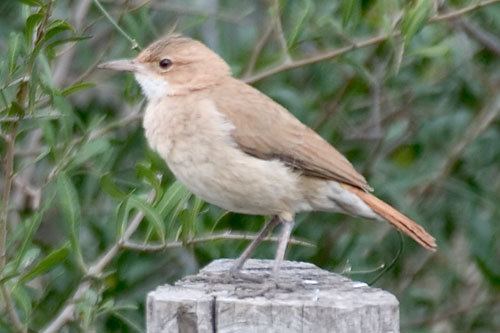
Predators
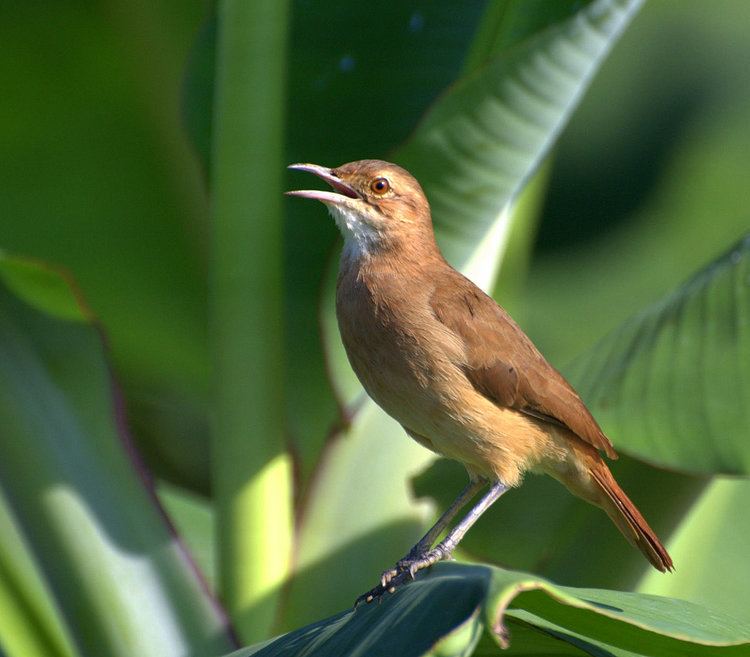
Predators of adult and young rufous horneros include birds of prey such as the black-chested buzzard-eagle Buteo melanoleucus, small mammals, domestic cats, and a number of species of snakes and possibly lizards. However, its covered nest probably reduces predation risk.
Breeding
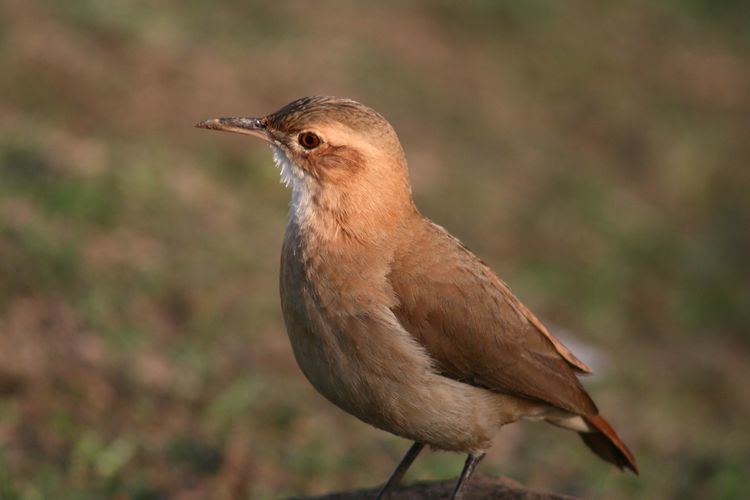
The rufous hornero breeds in the austral summer, laying eggs between August and December, raising nestlings soon after, and the young may stay in their natal territory until the following breeding season. The species is monogamous and the pair bond is long term, sometimes for life. The nest of the species is typical for the genus, a large thick clay "oven" placed on a tree, or man made structures such as fenceposts, telephone poles or buildings. Pairs remain together throughout the year and will work on the nest during that time; nests can be constructed in as little as 5 days but usually take longer, occasionally months, to complete. A clutch generally contains two to four eggs. The eggs are laid every second day and incubated for 14–18 days. Chicks are fed for 23–26 days before fledging; young birds remain in the parental territory for around 6 months after fledging and sometimes until the following breeding season. Both parents incubate eggs and feed the young. Horneros may or may not reuse nests, therefore it is quite common to see several nests close to each other (or even atop older nests) at the same nesting site. However, a formerly unused nest may be repaired for a new breeding season.
Status
The rufous hornero has benefited from human changes to the environment and many live in highly modified habitat, such as city suburbs. In turn abandoned nests may be of benefit to various other species of birds that nest in its unused "ovens". The saffron finch is one species that commonly nests in old ovenbird nests. The rufous hornero is a familiar sight over much of its range and has been adopted as the national bird of Argentina. It is not threatened by human activities and is listed as least concern by the IUCN.
Taxonomy and systematics
The first notes taken on the species were made by Philibert Commerson in 1767, from a specimen obtained at Barragán cove during Louis Antoine de Bougainville's expedition. Commerson named the bird as Turdus fulvus and his notes were later published by Georges Buffon in his Histoire Naturelle in 1779. However, the rufous hornero was first scientifically described, as Merops rufus, by the German naturalist Johann Friedrich Gmelin in the 13th edition of Systema Naturae published in 1788.
In 1816, Louis Jean Pierre Vieillot established the genus Furnarius in his Analyse d'une nouvelle ornithologie élémentaire and included the rufous hornero on it, although Vieillot did not directly renamed the rufous hornero as Furnarius rufus. Its current scientific name was used for the first time in ornithology by John Gould in his Zoology of the Voyage of H.M.S. Beagle in 1841.
Nowadays the rufous hornero integrates the genus Furnarius with other five species. They are all native to South America and build mud nests that resemble old wood-fired ovens. Its closest relative is the crested hornero, which is considered as its sister species due to similar behavior and plumage pattern.
The derivation of the current genus name, Furnarius, is from the Latin furnus, meaning "an oven". Its specific epithet comes from the Latin rufum, meaning "red" or "reddish". It is also known as the red ovenbird.
Subspecies
Five subspecies of the rufous hornero are generally recognized, based upon plumage and size:
Description
The rufous hornero is a medium-sized ovenbird at 18 to 20 centimetres (7–8 in) and 31 to 58 grams (1.1–2.05 oz), with males being heavier. It has a slender and slightly decurved bill suited to eating insects, which is horn-coloured with a length of 2.5 centimetres (1.0 in). Wings length is 10.2 centimetres (4 in), with males generally being larger. The tail is short at 7.1 centimetres (2.8 in). The measurements of the species may differ due to the Bergmann's rule.
The sexes are not dimorphic in their plumage. It has a rufous brown back and pale buffy brown underparts. Its wings are pale brown except for the flight feathers which are blackish with cinnamon wingbars.
